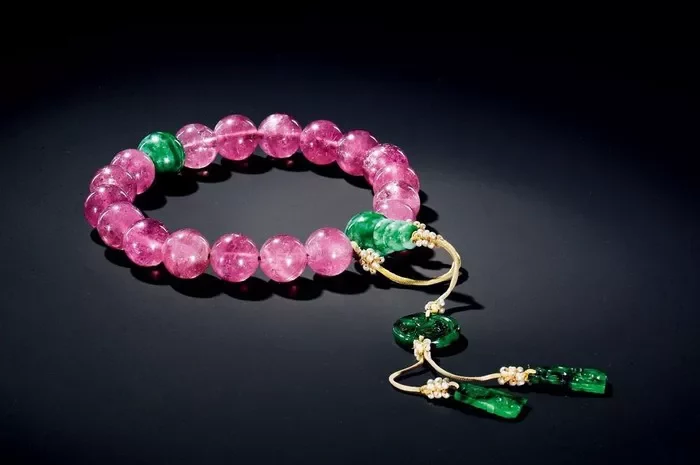Tourmaline, a gemstone renowned for its vibrant colors and unique electrical properties, holds a special place in the world of jewelry and gemology. Its formation is a fascinating process that involves a complex interplay of geological factors over millions of years. This article aims to provide a detailed and logical introduction to how tourmaline is formed naturally, using simple sentences and a popular science style.
The Origin of Tourmaline
Tourmaline belongs to the group of minerals known as borosilicates. It is characterized by its complex chemical composition, which typically includes elements such as aluminum, boron, silicon, oxygen, and varying amounts of other elements that give rise to its diverse colors. This mineral is found in a wide range of colors, from deep blues and greens to vibrant pinks and reds, making it a highly sought-after gemstone for jewelry creation.
Geological Setting
The formation of tourmaline begins in specific geological settings. It is most commonly found in pegmatites, which are coarse-grained igneous rocks that form when magma or lava cools slowly underground. Pegmatites are rich in minerals and often contain large crystals, including tourmaline.
These pegmatites can be found in various geological environments, such as volcanic rocks, granitic intrusions, and metamorphic rocks. The specific conditions that favor the formation of tourmaline include high temperatures, pressures, and the presence of specific chemical elements in the magma or surrounding rocks.
Crystallization Process
The crystallization of tourmaline occurs over a long period, typically millions of years. As magma cools and crystallizes, different minerals begin to form in a specific sequence. Tourmaline often crystallizes late in this process, after other minerals such as quartz and feldspar have already formed.
During crystallization, the elements present in the magma or surrounding rocks rearrange themselves into a structured lattice, forming the tourmaline crystals. This process is controlled by factors such as temperature, pressure, and the availability of specific elements. Variations in these factors can lead to differences in the color and composition of the resulting tourmaline crystals.
Role of Fluids
In addition to the cooling magma, fluids play a crucial role in the formation of tourmaline. These fluids, often rich in boron, lithium, and other elements, can migrate through the rocks and concentrate in fractures or cavities. As these fluids cool and interact with the surrounding rocks, they can precipitate tourmaline crystals.
The interaction between these fluids and the host rocks can also lead to the formation of metasomatic rocks, which are rocks altered by the introduction of new chemical elements. These altered rocks often provide the ideal environment for the crystallization of tourmaline.
Color Development
The diverse colors of tourmaline are a result of the varying chemical compositions of the crystals. Specific elements, such as vanadium, chromium, and manganese, substitute for other elements in the tourmaline structure, causing the crystals to absorb light at different wavelengths. This absorption results in the various colors observed in tourmaline gemstones.
For example, chromium can give rise to green tourmaline, while vanadium can produce blue tourmaline. The presence of multiple elements can lead to complex color combinations, such as pink tourmaline with greenish hues or bi-colored tourmaline with distinct color zones.
Unique Properties
Tourmaline is also known for its unique electrical and pyroelectric properties. These properties arise from the不对称 charge distribution within the tourmaline crystal structure. The crystals can develop a spontaneous polarization, meaning that they have a positive and negative end, even in the absence of an external electric field.
This polarization can lead to the development of an electric potential when the crystal is heated or cooled. This phenomenon is known as the pyroelectric effect and is responsible for some of the unique behaviors observed in tourmaline, such as its ability to attract lightweight particles like dust or paper shavings.
Occurrences and Mining
Tourmaline is found worldwide, with significant deposits in countries such as Brazil, Madagascar, Sri Lanka, and the United States. Mining for tourmaline typically involves the extraction of pegmatites, which can be challenging due to their hardness and the need for precise extraction techniques to preserve the crystals.
Once extracted, tourmaline crystals undergo various processing steps, including cutting, polishing, and grading, to transform them into the beautiful gemstones used in jewelry. The quality and value of tourmaline gemstones are determined by factors such as color, clarity, cut, and carat weight.
Conclusion
In summary, the natural formation of tourmaline is a remarkable process that involves a complex interplay of geological factors over millions of years. From its origin in pegmatites to its crystallization in specific geological settings, the formation of tourmaline is influenced by temperature, pressure, and the availability of specific chemical elements.
Related topic:
- Who Can Wear Green Tourmaline
- Which Finger to Wear Green Tourmaline?
- What is Black Tourmaline in Feng Shui?


